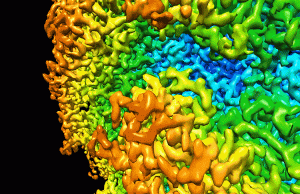Leemor Joshua-Tor of the Howard Hughes Medical Institute writes a new structural analysis of four norovirus strains reveals that the virus’s shell varies in size and molecular arrangement – a surprise finding that could help scientists developing vaccines.
 The discovery, reported June 10, 2019, in the journal Proceedings of the National Academy of Sciences, overturns nearly two decades of conventional wisdom about norovirus. Until now, the only structural data about the virus that scientists had came from a single, not particularly prevalent, strain.
The discovery, reported June 10, 2019, in the journal Proceedings of the National Academy of Sciences, overturns nearly two decades of conventional wisdom about norovirus. Until now, the only structural data about the virus that scientists had came from a single, not particularly prevalent, strain.
“Everyone thought that all the strains would look about the same – like the one that was solved 20 years ago,” says Howard Hughes Medical Institute Investigator Leemor Joshua-Tor. “It turns out that they don’t!”
Joshua-Tor’s team used a microscopy technique called cryo-electron microscopy (cryo-EM) to visualize the shells of four viral strains, including one responsible for up to roughly 80 percent of norovirus outbreaks. That strain was 71 percent larger (by volume) than the one previously reported. Its shell was also decorated with a different pattern of molecular spikes.
Those structural details will be crucial for scientists working on vaccines or antiviral therapies to treat norovirus infection, says Joshua-Tor, a structural biologist at Cold Spring Harbor Laboratory (CSHL). Though norovirus causes about 21 million cases of foodborne illness in the United States every year, there are currently no approved therapies.
At least one vaccine candidate is working its way through clinical trials now. But CSHL study coauthor James Jung says scientists will need to take the virus’s newfound variation into account – so any new vaccine protects against a broad array of strains.
